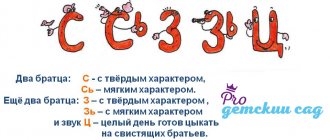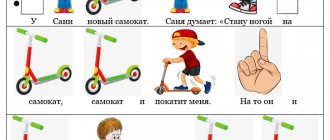Sibilants in a child's speech
Hissing ones include - [w], [zh], [h`], [sch`]. The formation of their correct pronunciation occurs between the third and fifth years of the baby’s life.
Incorrect pronunciation of “Sh”: types, reasons
Distortion or complete absence of sibilants in a child’s speech is called sigmatism. Depending on the type of incorrect placement, there are 4 types of sigmatism:
- Parasigmatism is a stable replacement of [sh] with another sound. Labial-dental - dental - replacement of [w] with [f]. Prizubny - replacing [w] with [t]. Hissing - replacing [w] with [sch]. Whistling - replacing [w] with [s] or [z]. Occurs with malocclusion or impaired phonemic hearing. Example: hat - slipper.
- Interdental sigmatism is the same “lisping” sound. Occurs due to a shortened frenulum or narrow soft palate.
Lesson with a specialist
- Lateral sigmatism - the sound [w] does not sound firm, as it should, but squelching, as if the baby had taken water into his mouth. Observed due to lateral open bite or weak tongue muscles.
- Nasal sigmatism - in a preschooler, the back of the tongue becomes very tense, and [w] can be pronounced with a nasal “echo.”
Before figuring out how to teach a child to pronounce the letter w, you should understand the reasons for the violation. Often a routine visit to the orthodontist, during which the bite or upper palate is corrected, ends with the long-awaited “hissing” of the baby. Otherwise, there is a need to develop the correct articulation pattern in speech therapy classes.
Articulation gymnastics for staging hissing
Before requiring the baby to pronounce a hissing sound, it is necessary to carry out preparatory articulatory gymnastics. Its duration is no more than 10 minutes. Despite the fast pace (so that the preschooler does not get bored), the child must perform each exercise carefully, since gymnastics directly determines how quickly a child can learn to say the sound [w].
Main tasks in articulatory gymnastics:
- Fence - a wide smile with teeth.
- Tube - the lips are gathered into a tube, there is a small gap between the lips.
- Alternating fence - tube.
- Hippopotamus - open your mouth wide and hold it for a while.
- Spatula - place a wide, outstretched tongue on the lower lip. You can “bite” with your tongue to make it wider.
- Homemade jam: lick the upper and then the lower lip with the tip of your tongue.
- Brush - move the tip of your tongue across the soft palate - from the throat to the teeth and back.
Articulation gymnastics
Tasks to determine the position of a sound in a word
At the beginning of the lesson, you can also develop phonemic awareness - determine the position of a sound in a word. To do this, you will need rich verbal and subject material.
- The child is asked to clap if he hears the “snake song (sound [sh]).” In this case, words are pronounced that contain the desired sound or do not contain them. You should not pronounce words with other hissing or mixed whistling sounds.
- The child is given a small sign with 3 windows indicating the beginning, middle and end of the word. And also a chip (cube/drawn sound). The teacher says the condition: “I will name the word, and you put the chip where the sound [w] is located.”
Complex of articulation gymnastics for children 4-5 years old in the middle group
Gymnastics for clear pronunciation
To correctly pronounce hissing sounds, speech therapy uses articulation and breathing exercises in combination. In this case, you should definitely remember about the correct position of the organs of articulation: lips and tongue.
Additional Information! Breathing exercises are aimed at developing smooth exhalation. To teach your child to perform breathing exercises, you need to create bright and interesting didactic material. For example, a flower with a butterfly sitting on it, which, according to the terms of the task, needs to be blown away.
Methodological basics for parents
It is important to know the correct position of the tongue and lips when pronouncing a sound in order to work on the exercises at home.
- Lips in the “tube” position;
- The tongue is wide, the tip is raised upward;
- The lateral parts of the tongue are in contact with the teeth of the upper jaw;
- A small gap forms between the palate and the tongue in the area of the upper incisors.
We present to your attention a presentation on the topic “Methods and techniques for producing hissing sounds.” As already mentioned, one of the components of success in the correctional work of a speech therapist is a clear understanding of the position of the organs of articulation of the sounds being corrected. The group of hissing sounds includes sounds such as sh, zh, ch, shch. The slides show articulatory profiles of these sounds.
The structure of the organs of articulation. When pronouncing the sound sh, the lips are rounded and slightly extended forward (before the subsequent vowel a, rounding is minimal; before s(i), there may be no rounding. The teeth are close together, but not touching, the distance between them is 2-5 mm, the upper and lower incisors are visible. The wide tip of the tongue is raised to the alveoli or the front part of the hard palate and forms a gap with them. The front part of the back of the tongue is wide, raised to the palate behind the alveoli (reminiscent of the shape of the front edge of a ladle), but does not touch the palate, but forms a gap with it. The middle part of the back the tongue is lowered, bends downwards (the depression in the middle forms, as it were, the bottom of a “bucket”).
part of the back of the tongue rises towards the soft palate and is pulled back. The lateral edges of the tongue are pressed against the upper molars and do not allow the escaping stream of air to pass through the sides. The soft palate is pressed against the back wall of the pharynx and closes the passage into the nasal cavity. The vocal cords are not tense, they are spread apart, the voice is not formed. The air stream is strong, wide, warm, and can be easily felt with the back of your hand brought to your mouth.
When the sound is formed, the articulation is the same as when the sound is formed; it is complemented by the work of closed and oscillating vocal folds that produce voice. The exhaled stream of air is somewhat weaker, and the gap between the tip of the tongue and the hard palate is smaller than when forming a w.
The sounds sh and z are always hard, z is voiced, sh is unvoiced.
The sound shch in Russian is pronounced as a long soft fricative sibilant. When pronouncing it, the lips are rounded and slightly moved forward. The wide tip of the tongue is raised to the level of the upper teeth (lower than when pronouncing sh). The front part of the back of the tongue bends slightly, the middle part rises towards the hard palate, the back part is lowered and moved forward. The tongue is tense. The velum is raised, the vocal folds are open. A strong stream of air passes through two slits: between the middle part of the back of the tongue and the hard palate and between the tip of the tongue and the front teeth or alveoli. A complex noise is formed, higher than with the sound sh. The sound is dull, always soft
When pronouncing the sound h, the lips, as when pronouncing all hissing sounds, are rounded and elongated. The sound has complex linguistic articulation: it begins with a stop element (as with the sound t). The tip of the tongue is lowered and touches the lower incisors. The front part of the back of the tongue is pressed against the upper incisors or alveoli, its middle part is curved towards the hard palate. The whole language moves forward somewhat. The sound ends with a short fricative element (as with the sound u). The boundary between the plosive and fricative (fricative) elements is not captured either aurally or articulatory, since the elements are fused together. The soft palate is raised and closes the passage to the nose, the vocal cords are open. The sound h is dull, always soft.
The articulation of hissing sounds has much in common with the articulation of whistling sounds. This similarity determines the similarity of pronunciation defects. Children exhibit the same types of distortion of hissing sounds; they are presented on the slide. Parasigmatism of sibilants manifests itself in such substitutions as:
w -s,t,f;
w-h,d,w:
sh – s, sh, t;
h – t, s.
The slide shows the order in which the sounds of a group of hissing sounds are produced.
There are several ways of producing sounds: by imitation, mechanical, mixed.
Techniques for making sounds [w], [zh], [sch], [h]
Preparatory stage.
In the absence of the sound [sh ], work begins with the formation of correct articulation of sound: the ability to slightly push the rounded lips forward is developed; raising the wide anterior edge of the tongue to the tubercles behind the upper teeth; the ability to press the lateral edges of the tongue to the upper molars; a long-lasting air stream running down the middle of the tongue. Staging. The technique of imitation is used and attention is paid to the correct position of the organs of the articulatory apparatus (they are asked to pronounce SA several times and during pronouncing, gradually (smoothly) raise the tongue up, the lips are slightly extended like a tube). With the mechanical method, probe No. 5 is used from the syllable SA, the tongue rises upward. Interdental sigmatism . Preparatory stage: exercises are carried out to lift the tip and front part of the back of the tongue by the upper teeth; generation of a directed air stream; the sound [t] is practiced, which requires lifting the tip of the tongue by the upper teeth. Staging. The child is asked, with his mouth open, to pronounce aspirated [t] 4-5 times at a slow pace, hitting the tubercles behind the upper teeth with the tip of his tongue; Gradually lengthen the exhaled stream and do not hit the tubercles, but only raise the tip of the tongue towards them. Lateral sigmatism . Preparatory stage: exercises are carried out to strengthen the lateral edges of the tongue, uniformly lift both halves of the tip and the front part of the back of the tongue upward; producing an air stream running in the middle of the tongue; [t] and [s] are processed. Staging. Mechanical assistance is used (probe No. 5, a flat, narrow, slightly curved handle from a teaspoon), lift the wide tongue behind the upper teeth, move it back to the tubercles, ask the child to lightly clamp the spoon with his teeth and pronounce [s] for a long time (all front teeth time are visible). Nasal sigmatism. Preparatory stage: the ability to hold a wide, spread tongue on the upper lip is developed; direct the air stream to the tip of the tongue raised on the upper lip; to distinguish by ear the sound of [w] in nasal and oral pronunciation, [t] and [s] are practiced. Setting [w] from [s] with mechanical assistance. If there is [p], then when pronouncing RA, use a spatula or probe No. 5 to stop the vibration of the tongue - a hissing is heard. When RA is pronounced in a whisper, SHA is heard, when pronounced loudly, ZHA is heard. Labiodental sigmatism . Preparatory stage: the child is taught to compare and distinguish by ear [w] - [f], using pictures-symbols; exercises are carried out to practice the upward and downward movements of the lower lip; lifting the wide front edge of the tongue upward. Staging. They put [w] by imitation, using visual control. Make sure that the lower lip is motionless and exposes the lower incisors (the lips can be held with your finger). Mechanical reception from [s] is possible. Dental sigmatism . Preparatory stage: the ability to compare and distinguish by ear [w] - [t] is developed, using pictures-symbols; distinguish the sounds [w] - [t] based on tactile sensations of the air stream ([w] - long, [t] - jerky); exercises for long-term directed air stream; the position of the wide anterior edge of the tongue at the tubercles behind the upper incisors; processed [s]. Staging: by imitation (visual control and tactile sensations). Hissing sigmatism . Preparatory stage: compare and distinguish [w] - [sch], using pictures-symbols; the ability to raise the wide front edge of the tongue to the tubercles behind the upper incisors; alternate movements of the wide tip of the tongue from the base of the upper incisors to the front of the hard palate (forward - backward). Staging. From [with] a mechanical technique (pushing the tongue back). Whistling sigmatism . Preparatory stage: compare and distinguish [s] - [w], using pictures-symbols; difference in air flow ([s] - cold, [w] - warm); upward movements of the wide tongue; alternating movements of the wide tongue for the lower - upper teeth; alternating lip movements: stretching into a smile - closed forward (tube). Sound production imitation technique. The sound [zh] is made from [sh] by connecting the vibration of the vocal folds. Automation. The delivered sound is sequentially introduced into syllables (direct, reverse, with confluence), words and phrasal speech. With sigmatisms, they end with the stage of automation, with parasigmatisms - differentiation of [w] with substitute sounds: with [f] with labial-dental, with [t] with dental, with [sch] with hissing, with [s] with whistling parasigmatisms. Among the disadvantages of pronunciation [ch], in addition to those that are common to all sibilants, it should be noted the replacement of [ch] with a soft whistling affricate [ts'], as well as the sounds [t'] or [sh']. The sound [h] is placed from [t]: with the tip of the tongue raised upward, it is moved further inland from the upper incisors. The child is asked to pronounce Тъ-Ть or Т'И (AT') with the tip of the tongue raised upward, while pushing the lips forward. You can use probe No. 5 to retract the tip of the tongue back. The correct pronunciation of [h] can also be achieved by pronouncing the sound combination ТШ simultaneously, first at a slow, then at a fast pace. Among the disadvantages of the pronunciation of [sch] there is a shortened pronunciation (as with [sh]), replacement of the sound [sch] with [s'], pronunciation of [sch] with an affricative element (like the combination Ш'Ч). The sound [š] often appears automatically after [š, zh, h] are placed. To evoke [sch], the child is asked to pronounce [sh] for a long time, stretch his lips into a smile, moving his tongue forward = [sch]. A mechanical method is possible: the child pronounces S'I or S'A several times, the speech therapist inserts a spatula or probe under the tongue and, at the moment of pronouncing the syllables, slightly lifts it, moving it back a little (or simply moving it away with the touch of a spatula).
The following exercises help develop the necessary movements of the tongue and air stream.
“Spatula”, “Pancake”,
"Swing"
“The tongue steps over the teeth” “Painter”.
"Fungus"
Goal: strengthen the muscles of the tongue, develop upward movement of the tongue, stretch the hyoid frenulum.
The mouth is open. Lips in a smile. Press the wide tongue with its entire plane against the palate (the tongue is suctioned) and hold it in this position, counting from 1 to 5-10. The tongue will resemble a thin cap of a fungus, and the stretched hyoid frenulum will resemble its stem. Make sure that the lateral edges of the tongue are equally tightly pressed to the palate (neither half should sag), so that the lips do not stretch over the teeth. When repeating the exercise, you need to open your mouth wider.
"Harmonic".
Goal: strengthen the muscles of the tongue, develop the ability to hold the tongue in a vertical position, stretch the hyoid frenulum.
The mouth is open. Lips in a smile. Press the wide tongue to the palate (the tongue is sucked) and, without lowering the tongue, open and close the mouth. When repeating the exercise, you should try to open your mouth wider and hold it in this position longer. Make sure that when you open your mouth, your lips are in a smile and remain motionless, and your tongue does not sag.
10."Delicious jam."
Goal: strengthen the muscles of the tongue, develop mobility of the tongue, develop the lifting of the wide front part of the tongue.
The mouth is open. Lips in a smile. Using the wide front edge of the tongue, lick the upper lip, moving the tongue from top to bottom, then pull the tongue into the mouth, towards the center of the palate. Be careful not to
tapered; when retracted, its lateral edges slid over the molars, and the tip of the tongue was raised. The lips do not stretch over the teeth, the lower jaw does not “pull” the tongue up - it should be motionless.
“Cup”, Purpose: to strengthen the muscles of the tongue, to develop the elevation of the lateral edges and tip of the tongue, the ability to hold the tongue in this position.
The mouth is open. Lips in a smile. Tongue out. The lateral edges and tip of the tongue are raised, the middle part of the back of the tongue is lowered, bending downwards. In this position, hold your tongue while counting from 1 to 5-10. Make sure that the lips do not stretch over the teeth and that the lower jaw is motionless.
"Focus". Goal: to develop the ability to hold the side edges and tip of the tongue in a raised state, to learn to direct the air stream along the middle of the tongue.
The mouth is open. Lips in a smile. Tongue out. The lateral edges and tip of the tongue are raised, the middle part of the back of the tongue bends downwards. Holding your tongue in this position, blow the cotton wool from the tip of your nose. Make sure that the lower jaw is motionless, the lips do not stretch over the teeth, and the cotton wool flies straight up.
"Speaker"
“Fence” - “Speaker” - “Tube”
Goal: strengthen the orbicularis oris muscle, develop the ability to quickly change the position of the lips.
The teeth are closed. The lips imitate the pronunciation of the sounds i-o-u.
"Slide"
Goal: to develop the lifting of the anterior-middle part of the back of the tongue, the ability to quickly change the position of the tongue.
The mouth is open. Lips in a smile. The wide tip of the tongue rests on the lower incisors, and the anterior-middle part of its back first rises until it comes into contact with the upper incisors, then lowers. Make sure that the lips do not stretch over the teeth and the lower jaw does not move
“Home” speech therapy sound [w]
To teach your child to pronounce [w] correctly at home, you need to learn several basic methods of production:
- mechanical;
- from a similar-sounding sound.
Mechanical setting
With this method, the baby does not need to independently search for the correct position of the sound - an adult does this for him, using special speech therapy tools (spatula, probe). If you need to put your hand into a preschooler’s mouth, it must be clean.
Mechanical staging process
Staging through sound [r]
How to learn to say the letter Ш through the sound [r]? It would seem that incorrect pronunciation of [r] is the most complex and most common speech defect. However, many children know how to pronounce [r] correctly, but do not understand at all how to position the tongue in the mouth in order to whistle and hiss correctly. For this reason, the sound should be produced through a solid [r], and not adjacent sibilants.
The preschooler should sit in front of the mirror and pronounce [r], gradually weakening the air pressure. The sound should be pronounced until the vibration completely disappears. After this, a slight hiss will be heard and [w] will sound without the auxiliary [r].
Speech therapy exercises on pronunciation of the sound [sh]
To consolidate the placed [w] in the baby’s speech, it is necessary to speak as much as possible with a separate sound - hiss during the game. For this, the preschooler is offered various exercises:
- move the snake along the path, and hiss at the same time;
- “finish” a word, for example - small ..(sh), karanda ..(sh), etc.
Sound culture of speech in the middle group of kindergarten
Working in words
You need to choose only those words that contain a practiced syllable. The work is carried out in the following order:
- the sound is at the beginning;
- in the middle;
- at the end.
Automation begins with words with forward and backward syllables. It is advisable to illustrate each name, invite toys to “visit” - all this will make the lesson not only more interesting, but also more effective.
Examples of exercises
Similar to the previous stage, in the first lessons the speech material is spoken by an adult, then together with the student, and then the child repeats it independently. Gradually, when there are more practiced words, the baby names them without prompting from the speech therapist.
At the stage of automation of phonemes in words, work is carried out in parallel on the development of phonetic-phonemic processes. The child is explained where the word has a beginning, middle and end. During the classes, word diagrams are drawn up and tasks for the development of auditory self-control are offered.
At the same stage of automation, the gradual introduction of the automated phoneme into coherent speech begins. They do this using the example of phrases, Ш or Ж can be either in one or in each word:
- Repetition of words:
SHA: ball, cap, puck.
SHU: noise, fur coat, joke.
JA: toad, heat, sting.
And in this way they select words for each practiced syllable.
- The child is asked to listen carefully to the words and correct the adult. An adult deliberately makes mistakes in the pronunciation of the automated sound in some words. This task is aimed at developing auditory control of speech.
- Add the desired syllable to make a word. Pictures are used with children of primary and middle preschool age to make it easier for them to complete this task. For example, given an image of a cap and the second syllable – PKA. The child needs to add a syllable from the proposed options (SHA).
- Repetition of words with two sounds Ш or Ж. For example: bump, panties, kidding, etc.
- Repetition of phrases: On W: grandfather’s checkers, new hat, funny joke, sewing machine.
- On F: a beetle is buzzing, an orange jacket, liquid jelly.
When the child manages to pronounce the sound in words correctly, they move on to a more complex stage of correctional work - automating sounds in sentences. This block is longer in terms of the proposed material, because it is a preparation for the introduction of an automated phoneme into coherent speech.










